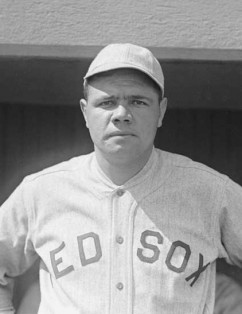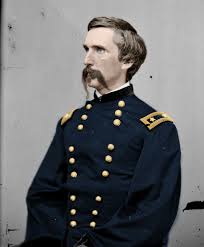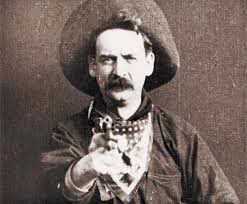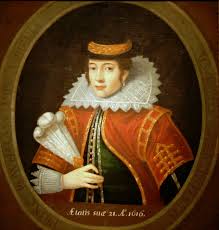| 1924 | Baseball’s first ‘colored World Series’ is held in Kansas City, Mo. |
The Man Who Shot Liberty Valance
Feeling lucky? Enter to win a copy of Tales Behind the Tombstones: The Deaths and Burials of some of the West’s Most Nefarious Outlaws, Notorious Women, and Celebrated Western Actors and Lawmen
After acting as either a cowboy or a soldier in nearly on hundred films, John Wayne finally won a best actor Oscar for True Grit (1969). The quintessential macho-man was himself exempt from service during World War II owing to an inner ear problem and a shoulder injury. Winning the Oscar, some say, added another ten years to his life. Although he was a longtime smoker, averaging four packs a day, Wayne nevertheless died of gastric cancer at age seventy-two in 1979.
In 1955 John Wayne was among two hundred twenty cast and crew members who worked on the film The Conqueror. It was shot on a location in Utah, which was contaminated by radioactive fallout atomic bomb tests. Much of the soil was transported back to Hollywood for studio scenes. By 1980 more than ninety of those who had worked on the movie contracted cancer; forty-six died. Even though Wayne knew of the danger, often carrying a Geiger counter onto the set, he believed the risk insignificant.
To learn more about the death of legendary characters read Tales Behind the Tombstones: The Deaths and Burials of some of the West’s Most Nefarious Outlaws, Notorious Women, and Celebrated Western Actors and Lawmen.
Sultan of Swat
Take a chance! Enter to win a copy of Tales Behind the Tombstones: The Deaths and Burials of some of the West’s Most Nefarious Outlaws, Notorious Women, and Celebrated Outlaws.
When the Death Row All Stars were playing ball at the Crossbar Hotel in Rawlins, Wyoming in 1911-1912, Babe Ruth was sitting in class at St. Mary’s Industrial School for Boys in Baltimore, Maryland.
George Herman Ruth, the Sultan of Swat, remains baseball’s greatest legend and its home run king, hitting 60 in one year, 714 in total, without carrying the stigma of suspected steroid and amphetamine use or asterisks after his name. He was born in Baltimore to saloon keepers, raised on the streets, and was in enough trouble by the age of seven that his father signed away custody to St. Mary’s Industrial School for Boys, a reform school. There, an athletic priest used baseball as a way to teach rules to the incorrigibles and to channel learning or behavioral disabilities into the love of a sport. According to tests conducted by psychologists at Columbia University in 1921, Ruth had been born with an above-average eye, ear, and muscle coordination due to hyperactive brain function, primarily in the posterior parietal cortex, the middle to rear section of the brain most often associated with spatial interpretations. Biologically, he might have been an equally good safe-cracker if never introduced to the game. Ruth’s ultimate death from throat cancer at the age of fifty-three in 1948 was due most probably to his penchant for smoking cigars, chewing tobacco, and dipping snuff. However, studies have now shown that his facial carcinoma, located in the nasopharynx, or the upper part of the throat behind the nose, are more often linked to other risk factors. The enhanced gamma-band activity (electrical signals) of his posterior parietal cortex, something he was born with, enabled him to pack the sensory stimuli of three lifetimes into one and might explain his well known womanizing, love of food, drink, and his excellence at baseball. The high-functioning spatial portion of his brain triggered his odd case of malignant cancer. What made him great – the anatomy of his brain – is what killed the Babe at a young age.
To learn more about the death of legendary characters read Tales Behind the Tombstones: The Deaths and Burials of some of the West’s Most Nefarious Outlaws, Notorious Women, and Celebrated Outlaws.
This Day…
Guns Down, Punk!
Enter to win a copy of Tales Behind the Tombstones: The Deaths and Burials of some of the West’s Most Nefarious Outlaws, Notorious Women, and Celebrated Outlaws.
General Joshua Chamberlain was in twenty-four battles and was wounded six times. He was chosen by Grant to receive the formal surrender of weapons and colors (April 12, 1865) from Robert E. Lee at Appomattox Court House in Virginia. During the ceremony he saluted the Confederate soldiers, an action that caused uproar in the North but which he defended as an act of honor among warriors. After the war, he was elected governor of Maine by the largest majority in the state’s history. He died at the age of eighty-five from complications of battle wounds, apparently having taken quite some time for those previous six battle scars to do their damage.
To learn more about the death of legendary characters read Tales Behind the Tombstones: The Deaths and Burials of some of the West’s Most Nefarious Outlaws, Notorious Women, and Celebrated Outlaws.
Wicked Women
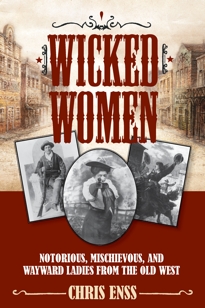
This collection of short, action-filled stories of the Old West’s most egregiously badly behaved female outlaws, gamblers, soiled doves, and other wicked women by award-winning Western history author Chris Enss offers a glimpse into Western Women’s experience that’s less sunbonnets and more six-shooters. During the late nineteenth century, while men were settling the new frontier and rushing off to the latest boom towns, women of easy virtue found wicked lives west of the Mississippi when they followed fortune hunters seeking gold and land in an unsettled territory. Prostitutes and female gamblers hoped to capitalize on the vices of the intrepid pioneers. Pulling together stories of ladies caught in the acts of mayhem, distraction, murder, and highway robbery, it will include famous names like Belle Starr and Big Nose Kate, as well as lesser known characters.
Toughest Man West of Anyplace East
Giveaway! Enter to win a copy of Tales Behind the Tombstones: The Deaths and Burials of some of the West’s Most Nefarious Outlaws, Notorious Women, and Celebrated Outlaws.
In 1839 Samuel Colt patented the revolving-chamber pistol. As a teen he had worked as a sailor and had spent long hours staring at the ship’s wheel. He used this principle to invent a gun that could shoot multiple bullets without reloading. He excelled at both invention and marketing and today would be considered a compulsive workaholic. He struggled with a way to produce his guns cheaply but was forced to find a method of mass production after he received an order from the U.S. government in 1847 for 1,000 revolvers. By the time he died of exhaustion at age forty-seven, Samuel Colt had produced more than 400,000 Colt .45 revolvers. At his funeral in 1862 it was said of the Colt .45 he invented: “God created man, but Sam Colt [the Colt .45] made them all equal.”
To learn more about the death of legendary characters read Tales Behind the Tombstones: The Deaths and Burials of some of the West’s Most Nefarious Outlaws, Notorious Women, and Celebrated Outlaws.
This Day…
On this day in 1866, the Reno gang carries out the first robbery of a moving train in the U.S., making off with over $10,000 from an Ohio & Mississippi train in Jackson County, Indiana. Prior to this innovation in crime, holdups had taken place only on trains sitting at stations or freight yards.
Little Spoiled One
Giveaway! Enter to win a copy of Tales Behind the Tombstones: The Deaths and Burials of some of the West’s Most Nefarious Outlaws, Notorious Women, and Celebrated Outlaws.
Pocahontas, a nickname meaning “little spoiled one,” was born Amonute, daughter of Chief Powhatan in 1595, She was an extrovert from a young age, inquisitive and naturally good-natured. At eleven years old she played a miner role in securing John Smith’s survival. Later she was the go-between for trade among the settlers and Indians bartering at Jamestown. The fictionalized version of her love affair with Smith may, in fact, bear some truth, but in a much more disturbing way for our modern sensibilities. Today, a thirty-year-old having sex with a preteen is pedophilia and a crime. But, in that era, relations with non-Christian pagans of any age was not considered wrong. Pocahontas was known to have “long, private conversations” with Smith during her frequent visits to the Jamestown complex, yet the true dimensions of the encounters are a matter of conjecture. A few years later she was betrothed to the older Englishman John Rolfe, only after she agreed to be baptized in 1614. Two years later Rolfe took her to London, where she was received as a celebrity, billed as a real live Indian princess by high society, and held an audience with King James. In 1617 she believed the smoky air of London was the cause of her coughs and bouts of weakness and wished to return to the forests she had known. Along with Rolfe she boarded a ship to return to Virginia, but the vessel only made it to the end of the Thames River before it turned back. Pocahontas died in London at age twenty-two of a disease called the king’s evil, a form of tuberculosis characterized by swelling of the lymph glands.
To learn more about the death of legendary characters read Tales Behind the Tombstones: The Deaths and Burials of some of the West’s Most Nefarious Outlaws, Notorious Women, and Celebrated Outlaws.
Mochi’s War
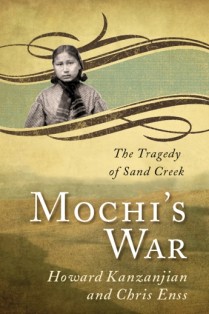
Colorado Territory in 1864 wasn’t merely the wild west, it was a land in limbo while the Civil War raged in the east and politics swirled around its potential admission to the union. The territorial governor, John Evans, had ambitions on the national stage should statehood occur–and he was joined in those ambitions by a local pastor and erstwhile Colonel in the Colorado militia, John Chivington. The decision was made to take a hard line stance against any Native Americans who refused to settle on reservations–and in the fall of 1864, Chivington set his sights on a small band of Cheyenne under the chief Black Eagle, camped and preparing for the winter at Sand Creek.When the order to fire on the camp came on November 28, one officer refused, other soldiers in Chivington’s force, however, immediately attacked the village, disregarding the American flag, and a white flag of surrender that was run up shortly after the soldiers commenced firing.
In the ensuing “battle” fifteen members of the assembled militias were killed and more than 50 wounded Between 150 and 200 of Black Kettle’s Cheyenne were estimated killed, nearly all elderly men, women and children.
As with many incidents in American history, the victors wrote the first version of history–turning the massacre into a heroic feat by the troops. Soon thereafter, however, Congress began an investigation into Chivington’s actions and he was roundly condemned. His name still rings with infamy in Colorado and American history. Mochi’s War explores this story and its repercussions into the last part of the nineteenth Century from the perspective of a Cheyenne woman whose determination swept her into some of the most dramatic and heartbreaking moments in the conflicts that grew through the West in the aftermath of Sand Creek.


